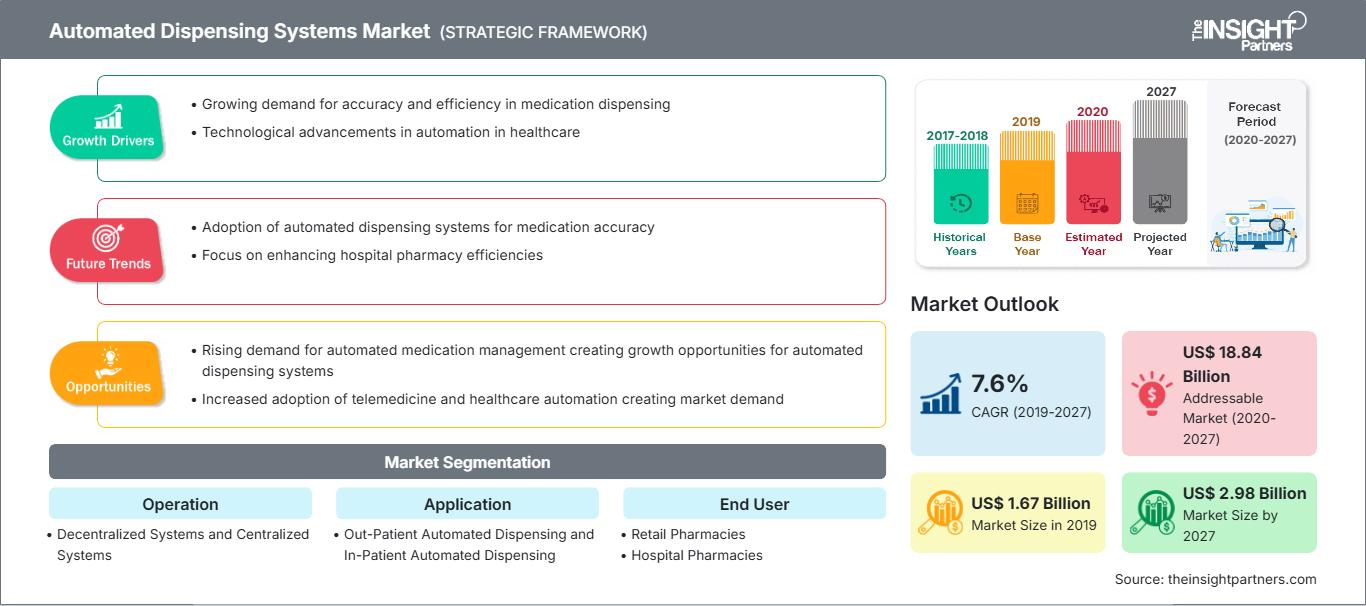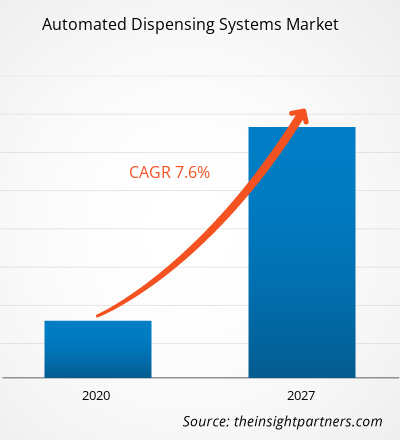Der Markt für automatisierte Abgabesysteme soll von 1.665,78 Millionen US-Dollar im Jahr 2019 auf 2.980,38 Millionen US-Dollar im Jahr 2027 anwachsen; für den Zeitraum 2020–2027 wird ein CAGR von 7,6 % prognostiziert.
Automatisierte Abgabesysteme, auch Medikamentenschränke genannt, sind elektronische Geräte zur Aufbewahrung und Abgabe von Medikamenten, die vorwiegend im Gesundheitswesen eingesetzt werden. Diese Systeme helfen bei der Verfolgung und Kontrolle der Medikamentenverteilung; sie sind mit authentifizierten Passwörtern und biometrischen Daten zur Bestandskontrolle und zum Schutz der Medikamente vor Diebstahl gesichert. Diese Systeme gelten als eines der potenziellen Instrumente zur Verbesserung der Betriebseffizienz und der Patientensicherheit. Darüber hinaus werden sie mittlerweile häufig unter anderem in Kliniken und Pflegeheimen eingesetzt. Automatisierte Abgabesysteme tragen dazu bei, Krankenhäuser in sicherere, effizientere und effektivere Einrichtungen umzuwandeln.
Der globale Markt für automatisierte Abgabesysteme wird von Faktoren wie zunehmenden Medikationsfehlern und der steigenden Zahl geriatrischer Patienten getrieben. Allerdings können Probleme im Zusammenhang mit automatisierten Dosiersystemen, wie z. B. falsche Programmeingaben, Geräteausfälle usw., das Marktwachstum behindern. Darüber hinaus bieten Schwellenmärkte den Marktteilnehmern Wachstumschancen.
Passen Sie diesen Bericht Ihren Anforderungen an
Sie erhalten kostenlos Anpassungen an jedem Bericht, einschließlich Teilen dieses Berichts oder einer Analyse auf Länderebene, eines Excel-Datenpakets sowie tolle Angebote und Rabatte für Start-ups und Universitäten.
Markt für automatisierte Abgabesysteme: Strategische Einblicke

- Holen Sie sich die wichtigsten Markttrends aus diesem Bericht.Dieses KOSTENLOSE Beispiel umfasst Datenanalysen, die von Markttrends bis hin zu Schätzungen und Prognosen reichen.
Sie erhalten kostenlos Anpassungen an jedem Bericht, einschließlich Teilen dieses Berichts oder einer Analyse auf Länderebene, eines Excel-Datenpakets sowie tolle Angebote und Rabatte für Start-ups und Universitäten.
Markt für automatisierte Abgabesysteme: Strategische Einblicke

- Holen Sie sich die wichtigsten Markttrends aus diesem Bericht.Dieses KOSTENLOSE Beispiel umfasst Datenanalysen, die von Markttrends bis hin zu Schätzungen und Prognosen reichen.
Markteinblicke
Zunehmende Medikationsfehler
Eine irrationale, unangemessene und ineffektive Medikamentenverabreichung kann zu schweren Medikationsfehlern führen, die Patienten schaden können. Einige der häufigsten Medikationsfehler sind die Abgabe eines falschen Medikaments, die Abgabe einer falschen Medikamentenmenge, die Abgabe eines Medikaments mit der falschen Stärke und das Auslassen von Artikeln. ~75 % der Medikationsfehler werden durch Ablenkung verursacht, da das medizinische Fachpersonal mit mehreren Aufgaben beschäftigt ist, wie z. B. der Untersuchung von Patienten, Gesprächen mit Fachärzten, Gesprächen mit Angehörigen von Patienten oder der Unterhaltung mit Versicherungsfachleuten.
Jährlich erhält die US-amerikanische Food and Drug Administration (FDA) über 100.000 Berichte im Zusammenhang mit Medikationsfehlern. Darüber hinaus gehen laut der Studie „Medication Errors“ Wie im Juni 2020 in StatPearls veröffentlicht, sterben in den USA jedes Jahr etwa 7.000–9.000 Menschen an den Folgen von Medikationsfehlern. Ebenso ereignen sich laut den Schätzungen der 2018 in England veröffentlichten Studie „Prävalenz und wirtschaftliche Belastung durch Medikationsfehler im englischen NHS“ jedes Jahr etwa 237 Millionen Medikationsfehler im NHS, und vermeidbare unerwünschte Arzneimittelwirkungen (UAW) führen zu Hunderten von Todesfällen.
Betriebsbasierte Erkenntnisse
Basierend auf dem Betrieb ist der Markt für automatische Abgabesysteme in dezentrale und zentrale Systeme segmentiert. Das Segment der zentralisierten Systeme hatte 2019 einen größeren Marktanteil aufgrund von Faktoren wie dem wachsenden Bedarf an Kostensenkungen, Sicherstellung der Medikamentenverfügbarkeit und Modernisierung der Ressourcenzuweisung. Darüber hinaus wird erwartet, dass dezentrale Systeme im Prognosezeitraum eine höhere durchschnittliche jährliche Wachstumsrate (CAGR) auf dem Markt verzeichnen.
Anwendungsbasierte Erkenntnisse
Basierend auf der Anwendung ist der Markt für automatisierte Abgabesysteme in stationäre und ambulante automatisierte Abgabesysteme segmentiert. Das Segment der stationären automatisierten Abgabe hielt 2019 den größten Marktanteil; für die ambulante automatisierte Abgabe wird im Prognosezeitraum jedoch eine höhere CAGR erwartet.
Endnutzerbasierte Erkenntnisse
Basierend auf dem Endnutzer ist der Markt für automatisierte Abgabesysteme in Krankenhausapotheken, Einzelhandelsapotheken und Sonstige segmentiert. Das Segment der Krankenhausapotheken hielt 2019 den größten Marktanteil; für das Segment der Einzelhandelsapotheken wird im Prognosezeitraum jedoch die höchste CAGR des Marktes erwartet.
Produkteinführungen und -zulassungen sind die gängigsten Strategien von Unternehmen, um ihre globale Präsenz und ihr Produktportfolio zu erweitern; diese Strategien helfen ihnen, die wachsende Verbrauchernachfrage zu befriedigen. Zusammenarbeit ist eine der wichtigsten Strategien der Marktteilnehmer für automatisierte Abgabesysteme, um ihren Kundenstamm weltweit zu erweitern und ihren Markennamen weltweit zu wahren.
Automatisierte AbgabesystemeRegionale Einblicke in den Markt für automatisierte Abgabesysteme
Die Analysten von The Insight Partners haben die regionalen Trends und Faktoren, die den Markt für automatisierte Dosiersysteme im Prognosezeitraum beeinflussen, ausführlich erläutert. In diesem Abschnitt werden auch die Marktsegmente und die geografische Lage für automatisierte Dosiersysteme in Nordamerika, Europa, im asiatisch-pazifischen Raum, im Nahen Osten und Afrika sowie in Süd- und Mittelamerika erörtert.
Umfang des Marktberichts zu automatisierten Abgabesystemen
| Berichtsattribut | Einzelheiten |
|---|---|
| Marktgröße in 2019 | US$ 1.67 Billion |
| Marktgröße nach 2027 | US$ 2.98 Billion |
| Globale CAGR (2019 - 2027) | 7.6% |
| Historische Daten | 2017-2018 |
| Prognosezeitraum | 2020-2027 |
| Abgedeckte Segmente |
By Betrieb
|
| Abgedeckte Regionen und Länder | Nordamerika
|
| Marktführer und wichtige Unternehmensprofile |
|
Dichte der Marktteilnehmer für automatisierte Abgabesysteme: Verständnis ihrer Auswirkungen auf die Geschäftsdynamik
Der Markt für automatisierte Dosiersysteme wächst rasant. Die steigende Nachfrage der Endverbraucher ist auf Faktoren wie veränderte Verbraucherpräferenzen, technologische Fortschritte und ein stärkeres Bewusstsein für die Produktvorteile zurückzuführen. Mit der steigenden Nachfrage erweitern Unternehmen ihr Angebot, entwickeln Innovationen, um den Bedürfnissen der Verbraucher gerecht zu werden, und nutzen neue Trends, was das Marktwachstum weiter ankurbelt.

- Holen Sie sich die Markt für automatisierte Abgabesysteme Übersicht der wichtigsten Akteure
Globaler Markt für automatisierte Abgabesysteme – nach Betrieb
- Dezentrale Systeme
- Zentralisierte Systeme
Globaler Markt für automatisierte Abgabesysteme – nach Anwendung
- Ambulante automatisierte Abgabe
- Stationäre automatisierte Abgabe
Globaler Markt für automatisierte Abgabesysteme – nach Endbenutzer
- Einzelhandelsapotheken
- Krankenhausapotheken
- Sonstige
Markt für automatisierte Abgabesysteme – nach Geografie
Nordamerika
- USA
- Kanada
- Mexiko
Europa
- Frankreich
- Deutschland
- Italien
- Großbritannien
- Spanien
- Restliches Europa
Asien-Pazifik (APAC)
- China
- Indien
- Südkorea
- Japan
- Australien
- Restlicher Asien-Pazifik-Raum
Naher Osten und Afrika (MEA)
- Südafrika
- Saudi-Arabien
- VAE
- Restlicher Naher Osten und Afrika
Süd- und Zentralafrika Amerika
- Brasilien
- Argentinien
- Restliches Südamerika
Firmenprofile
- Cerner Corporation
- Capsa Healthcare
- Omnicell, Inc
- BD
- ARxIUM
- Accu-Chart Plus Healthcare Systems, Inc
- Innovation Associates
- RxMedic Systems, Inc
- Swiss log Holding Ltd
- Willach Pharmacy Solutions GmbH
- Historische Analyse (2 Jahre), Basisjahr, Prognose (7 Jahre) mit CAGR
- PEST- und SWOT-Analyse
- Marktgröße Wert/Volumen – Global, Regional, Land
- Branchen- und Wettbewerbslandschaft
- Excel-Datensatz
Aktuelle Berichte
Erfahrungsberichte
Grund zum Kauf
- Fundierte Entscheidungsfindung
- Marktdynamik verstehen
- Wettbewerbsanalyse
- Kundeneinblicke
- Marktprognosen
- Risikominimierung
- Strategische Planung
- Investitionsbegründung
- Identifizierung neuer Märkte
- Verbesserung von Marketingstrategien
- Steigerung der Betriebseffizienz
- Anpassung an regulatorische Trends




















 Kostenlose Probe anfordern für - Markt für automatisierte Abgabesysteme
Kostenlose Probe anfordern für - Markt für automatisierte Abgabesysteme